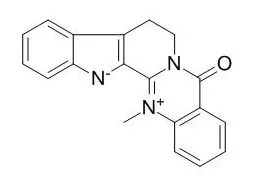| Description: |
Dehydroevodiamine has anticholinesterase activity and an anti-amnesic effect, it also may be a novel and effective ligand for improvement of beta-amyloid type amnesia. Dehydroevodiamine has antiarrhythmic, and anti-inflammatory properties, the effect of dehydroevodiamine-mediated inhibition of the expression LPS-induced iNOS and COX-2 genes is due to under the suppression of NF-kappaB activation in the transcriptional level.
|
| Targets: |
Beta Amyloid | NOS | COX | PGE | NF-kB |
| In vitro: |
| J Ethnopharmacol. 2014 May 14;153(3):753-62. | | Antiarrhythmic effects of dehydroevodiamine in isolated human myocardium and cardiomyocytes.[Pubmed: 24680993 ] | Dehydroevodiamine alkaloid (DeHE), a bioactive component of the Chinese herbal medicine Wu-Chu-Yu (Evodiae frutus), exerted antiarrhythmic effect in guinea-pig ventricular myocytes. We further characterize the electromechanical effects of DeHE in the human atrial and ventricular tissues obtained from hearts of patients undergoing corrective cardiac surgery or heart transplantation.
METHODS AND RESULTS:
The transmembrane potentials of human myocardia were recorded with a traditional microelectrode technique while sarcolemmal Na(+) and Ca(2+) currents in single human cardiomyocytes were measured by a whole-cell patch-clamp technique. The intracellular pH (pHi) and Na(+)-H(+) exchanger (NHE) activity were determined using BCECF-fluorescence in human atria.
In human atria, DeHE (0.1-0.3 μM) depressed upstroke velocity, amplitude of action potential, and contractile force, both in slow and fast response action potential. Moreover, the similar depressant effects of DeHE were found in human ventricular myocardium. Both in isolated human atrial and ventricular myocytes, DeHE (0.1-1 μM) reversibly, concentration-dependently decreased the Na(+) and Ca(2+)currents. Moreover, DeHE (0.1 and 0.3 μM) suppressed delayed afterdepolarizations and aftercontractions, induced by epinephrine and high [Ca(2+)]o in atria. In human ventricular myocardium, the strophanthidin-induced triggered activities were attenuated by pretreating DeHE (0.3 μM). The resting pHi and NHE activity were also significantly increased by DeHE (0.1-0.3 μM).
CONCLUSIONS:
We concluded for the first time that, in the human hearts, DeHE could antagonize triggered arrhythmias induced by cardiotonic agents through a general reduction of the Na(+) and Ca(2+) inward currents, while increase of resting pHi and NHE activity. |
|
| In vivo: |
| Eur J Pharmacol. 2001 Feb 16;413(2-3):221-5. | | Dehydroevodiamine attenuates beta-amyloid peptide-induced amnesia in mice.[Pubmed: 11226396] | Dehydroevodiamine has been reported to have anticholinesterase activity and an anti-amnesic effect.
METHODS AND RESULTS:
This study examined the effects of Dehydroevodiamine on scopolamine- and beta-amyloid peptide-(25--35)-induced amnesia in mice, using a step-through passive avoidance test. Similarly to the cholinesterase inhibitor, physostigmine (0.03--0.3 mg/kg, i.p.), Dehydroevodiamine (0.75--12.0 mg/kg, i.p.) administered 30 min before the training trial, immediately after the training trial, and 30 min before the retention test significantly improved scopolamine- and beta-amyloid peptide-(25--35)-induced amnesia. In beta-amyloid peptide-(25--35)-induced amnesia, the rank order of anti-amnesic potency in these three administration schedules for Dehydroevodiamine was different from that for physostigmine. Furthermore, Dehydroevodiamine was more potent to improve beta-amyloid peptide-(25--35)-induced amnesia than scopolamine-induced amnesia when administered before the training trial.
CONCLUSIONS:
These results suggested that Dehydroevodiamine may have an action other than that of an anticholinesterase and may be a novel and effective ligand for improvement of beta-amyloid type amnesia. |
|






 Cell. 2018 Jan 11;172(1-2):249-261.e12. doi: 10.1016/j.cell.2017.12.019.IF=36.216(2019)
Cell. 2018 Jan 11;172(1-2):249-261.e12. doi: 10.1016/j.cell.2017.12.019.IF=36.216(2019) Cell Metab. 2020 Mar 3;31(3):534-548.e5. doi: 10.1016/j.cmet.2020.01.002.IF=22.415(2019)
Cell Metab. 2020 Mar 3;31(3):534-548.e5. doi: 10.1016/j.cmet.2020.01.002.IF=22.415(2019) Mol Cell. 2017 Nov 16;68(4):673-685.e6. doi: 10.1016/j.molcel.2017.10.022.IF=14.548(2019)
Mol Cell. 2017 Nov 16;68(4):673-685.e6. doi: 10.1016/j.molcel.2017.10.022.IF=14.548(2019)